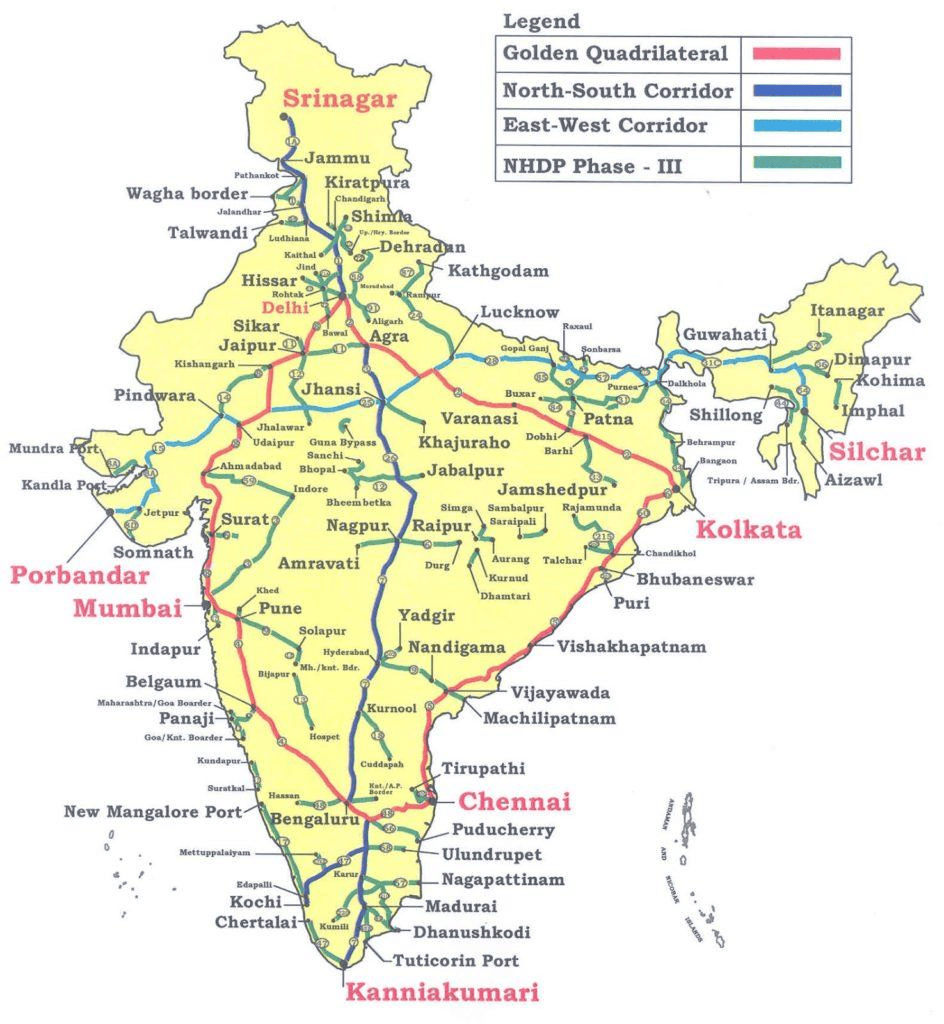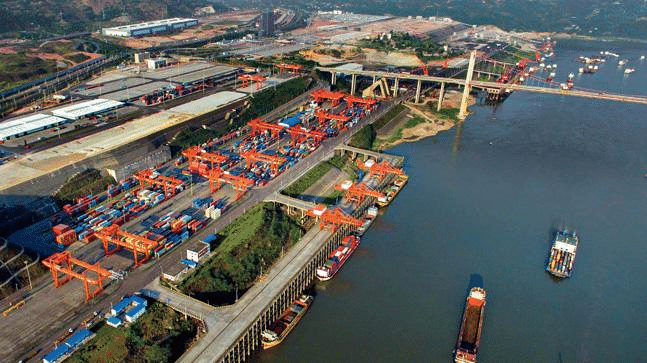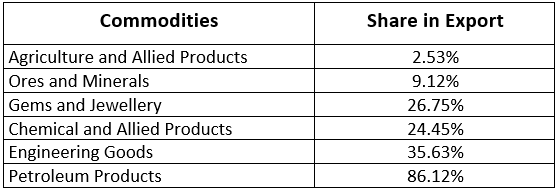Class 10 Geography Chapter 7 Notes - Lifelines of National Economy
| Table of contents |

|
| Introduction |

|
| Transport |

|
| Roadways |

|
| Railways |

|
| Pipelines |

|
| Waterways |

|
| Airways |

|
| Communication |

|
| International Trade |

|
| Tourism as a Trade |

|
Introduction
The pace of development of a country depends upon the production of goods and services as well as their movement over space. Therefore, efficient means of transport are pre-requisites for fast development.

The development of a nation relies on producing goods and services and their efficient movement. Key elements include:
- Efficient Transport: Essential for moving raw materials to factories and finished products to consumers.
- Seamless Communication: Vital for the flow of information, supporting economic activities.
- Global Connectivity: India’s integration with the world boosts trade and enriches the economy.
- Trade Networks: Dense transport and communication networks are crucial for local, national, and global trade.
Transport
- Transport plays an important role in the economy. We rely on various materials and services, some available locally, others brought from distant places.
- Goods and services require transportation to move from supply locations to demand locations. Traders facilitate this movement, bringing products to consumers.

- Types of Transport:
- Transport occurs over three main domains: land, water, and air.
- These correspond to the three types of transport: land transport, water transport, and air transport. - Expansion of Trade and Transport:
- Initially, trade and transport were limited to small areas.
- Advances in science and technology have expanded trade and transport globally.
- Today, the world functions like a large village, thanks to fast and efficient transport systems. - Integration with Communication:
- Transport is closely linked with communication systems, making them complementary.
- Together, they enable the smooth functioning of trade and economic activities. - India's Connectivity:
- Despite its vast size and diversity, India is well-connected with the world.
- Various modes of transport and communication, such as railways, airways, waterways, newspapers, radio, TV, cinema, and the internet, contribute to India's socio-economic progress. - Impact on the Economy:
- Trade, from local to international levels, boosts the economy and enhances the quality of life.
- The growth of amenities and facilities has significantly improved living standards.
Roadways
Second Largest Network: India has the second largest road network in the world, totaling about 62.16 lakh km (2020–21).
Historical Precedence: Roadways preceded railways in India and still maintain an edge due to ease of construction and maintenance.
Advantages Over Railways:
- Lower Construction Cost: Roads are cheaper to build compared to railway lines.
- Adaptability to Terrain: Roads can navigate more dissected, undulating topography and higher slopes, including mountainous regions like the Himalayas.
- Economical for Short Distances: Ideal for transporting a few people and small quantities of goods over short distances.
- Door-to-Door Service: Provides direct access, reducing loading and unloading costs.
- Feeder to Other Modes: Roads connect to railways, airports, and seaports, enhancing overall transport efficiency.

In India, roads are classified into the following six classes according to their capacity:

1. Golden Quadrilateral Super Highways
- The government has launched a major road development project linking Delhi-Kolkata- Chennai-Mumbai and Delhi by six-lane Super Highways.
- The North-South corridors linking Srinagar (Jammu & Kashmir) and Kanyakumari (Tamil Nadu), and East-West Corridor connecting Silcher (Assam) and Porbander (Gujarat) are part of this project.
- Aims to reduce travel time and distance between major cities.
- Implemented by the National Highway Authority of India (NHAI).
2. National Highways
- Primary road systems connecting extreme parts of the country.
- These are the primary road systems and are laid and maintained by the Central Public Works Department (CPWD).
- Major National Highways run in North-South and East-West directions.
 India: Highways
India: Highways
3. State Highways
- Roads linking a state capital with different district headquarters are known as State Highways.
- These roads are constructed and maintained by the State Public Works Department (PWD) in State and Union Territories.
4. District Roads
- Connect the district headquarters with other places of the district.
- The Zila Parishad maintains these roads.
5. Other Roads
- Rural roads, which link rural areas and villages with towns, are classified under this category.
- These roads received special impetus under the Pradhan Mantri Grameen Sadak Yojana.
- Under this scheme, special provisions are made to link every village in the country to a major town in the country by an all-season motorable road.
6. Border Roads
- Apart from these, the Border Roads Organisation a Government of India undertaking constructs and maintains roads in the bordering areas of the country.
- This organisation was established in 1960 for the development of roads of strategic importance in the northern and northeastern border areas.
- These roads have improved accessibility in areas of difficult terrain and have helped in the economic development of these areas.
- The Indian Railways is the largest public sector undertaking in the country.
- The first train steamed off from Mumbai to Thane in 1853, covering a distance of 34 km. Concrete or even bitumen of coal, therefore, these are all-weather roads. Unmetalled roads go out of use in the rainy season.
Road Density:
- The length of road per 100 sq. km of area is known as the density of roads.
- Distribution of road is not uniform in the country.
- The density of all roads varies from only 10 km in Jammu & Kashmir to 375 km in Kerala with the national average of 75 km (1996-97).
- Road transportation in India faces a number of problems. Keeping in view the volume of traffic and passengers, the road network is inadequate.
- About half of the roads are unmetalled, and this limits their usage during the rainy season.
- The National Highways are inadequate too.
- Moreover, the roadways are highly congested in cities, and most of the bridges and culverts are old and narrow.
Railways
Railways are the principal mode of transportation for freight and passengers in India.
- Railways also make it possible to conduct multifarious activities like business, sightseeing, pilgrimage, and transportation of goods over longer distances.
- Apart from an important means of transport, the Indian Railways have been a great integrating force for more than 150 years.
- Railways in India bind the economic life of the country as well as accelerate the development of industry and agriculture.

Rail Network: The Indian Railways have a network of 7, 031 stations spread over a route length of 63, 221 km. with a fleet of 7817 locomotives, 5321 passenger service vehicles, 4904 other coach vehicles and 228, 170 wagons as on 31.
Rail Gauge and Length of Routes in India

Development of Railways:
- Reorganized into 16 Zones: Indian Railways is divided into 16 zones, influenced by various factors.
- Distribution Influences:
- Northern Plains: Favorable due to vast level land, high population density, and rich agricultural resources, though river bridges posed challenges.
- Peninsular Region: Railway tracks laid through low hills, gaps, or tunnels due to hilly terrain.
- Himalayan Region: Unfavorable for railway construction due to high relief, sparse population, and limited economic opportunities.
- Challenging Terrains: Sandy plains of western Rajasthan, swamps of Gujarat, and forested areas of Madhya Pradesh, Chhattisgarh, Orissa, and Jharkhand posed difficulties.
- Sahyadri Range: Railway lines cross through gaps or passes (Ghats).
- Konkan Railway Development:
- Facilitated movement along the west coast, boosting economic activity.
- Faced issues like track sinking and landslides.
- Importance & Challenges:
- Railways play a crucial role in the national economy, surpassing other transport modes.
- Problems: Ticketless travel, theft, property damage, unnecessary train stops, and chain pulling cause significant issues and damages.
Pipelines
- The pipeline transport network is a new arrival on the transportation map of India.
- In the past, these were used to transport water to cities and industries.
- These are used for transporting crude oil, petroleum products and natural gas from oil and natural gas fields to refineries, fertilizer factories and big thermal power plants.
 Oil Pipeline
Oil Pipeline - Solids can also be transported through a pipeline when converted into the slurry.
- The far inland locations of refineries like Barauni, Mathura, Panipat and gas-based fertilizer plants could be thought of only because of pipelines.
- The initial cost of laying pipelines is high, but subsequent running costs are minimal.
- It rules out trans-shipment losses or delays.
- There are three important networks of pipeline transportation in the country:
(i) From oil field in upper Assam to Kanpur (Uttar Pradesh), via Guwahati, Barauni and Allahabad. It has branches from Barauni to Haldia, via Rajbandh, Rajbandh to Maurigram and Guwahati to Siliguri.
(ii) From Salaya in Gujarat to Jalandhar in Punjab, via Viramgam, Mathura, Delhi and Sonipat. It has branches to connect Koyali (near Vadodara, Gujarat) Chakshu and other places.
(iii) Gas pipeline from Hazira in Gujarat connects Jagdishpur in Uttar Pradesh, via Vijaipur in Madhya Pradesh. It has branches to Kota in Rajasthan, Shahajahanpur, Babrala and other places in Uttar Pradesh.
Waterways
- Waterways are the cheapest means of transport.
- They are most suitable for carrying heavy and bulky goods. It is a fuel-efficient and environment-friendly mode of transport.
 Waterways
Waterways
- India has inland navigation waterways of 14,500 km in length.
- Out of these, only 3,700 km are navigable by mechanised boats.
- National Waterways:
- N.W. No.1: Ganga River (Allahabad to Haldia, 1620 km).
- N.W. No.2: Brahmaputra River (Sadiya to Dhubri, 891 km).
- N.W. No.3: West-Coast Canal in Kerala (Kottapuram-Kollam, Udyogamandal, and Champakkara canals, 205 km).
- N.W. No.4: Stretches of Godavari and Krishna rivers with Kakinada-Puducherry canals (1078 km).
- N.W. No.5: Brahmani River, Matai River, Mahanadi-Brahmani delta channels, and East Coast Canal (588 km).
- Other Important Waterways: Mandavi, Zuari, Cumberjua, Sunderbans, Barak, and Kerala backwaters also see substantial transport activity.
- Foreign Trade: 95% of India's trade volume (68% by value) is conducted via sea ports along the coast.
Major Sea Ports
- With a long coastline of 7,516.6 km, India is dotted with 12 major and 181 medium and minor ports.
- These major ports handle 95 per cent of India’s foreign trade.

- Kandla (Deendayal Port):
- First port developed post-Independence to reduce pressure on Mumbai after losing Karachi to Pakistan.
- A tidal port serving a vast hinterland, including Jammu and Kashmir, Himachal Pradesh, Punjab, Haryana, Rajasthan, and Gujarat. - Mumbai Port:
- Largest port with a spacious natural harbor.
- Jawaharlal Nehru Port (Nhava Sheva) was developed to decongest Mumbai and act as a hub for the region. - Marmagao port (Goa): Premier iron ore exporting port, handling about 50% of India's iron ore exports.
- New Mangalore port: Located in Karnataka, it primarily exports iron ore concentrates from the Kudremukh mines.
- Kochchi Port: Located in the extreme southwest, it is a natural harbor at the entrance of a lagoon.
- Tuticorin Port:
- Extreme southeastern port in Tamil Nadu with a natural harbor and rich hinterland.
- Handles diverse cargo, including trade with neighboring countries like Sri Lanka and Maldives. - Chennai Port: One of the oldest artificial ports in the country. It is ranked next to Mumbai in terms of the volume of trade and cargo.
- Vishakhapatnam Port: Deepest landlocked and well-protected port, initially developed for iron ore exports.
- Paradip Port: Located in Orissa specialises in the export of iron ore.
- Kolkata Port:
- Inland riverine port serving the Ganga-Brahmaputra basin.
- Requires constant dredging of the Hoogly River due to its tidal nature.
- Haldia Port was developed to ease the pressure on Kolkata.
Airways
- Air transport was nationalised in 1953. On the operational side, Indian Airlines, Alliance Air (a subsidiary of Indian Airlines), private scheduled airlines and non-scheduled operators provide domestic air services.
- Fastest and Most Comfortable Transport: Air travel is the quickest, most comfortable, and prestigious mode of transport today.
- Versatility in Terrain: Capable of covering difficult terrains such as high mountains, deserts, dense forests, and long oceanic stretches with ease.
- Northeastern India: Air travel is particularly crucial for the northeastern region, which is characterized by big rivers, dissected relief, dense forests, frequent floods, and international borders, enhancing accessibility.
- Pawanhans Helicopters Ltd.:
- Provides helicopter services for Oil and Natural Gas Corporation's offshore operations.
- Serves inaccessible areas and challenging terrains, including the northeastern states, and the interior regions of Jammu and Kashmir, Himachal Pradesh, and Uttarakhand.

Communication
Personal communication and mass communication, including television, radio, press, films, etc., are the major means of communication in the country.
Indian Post
- The Indian postal network is the largest in the world. It handles parcels as well as personal written communications.
 Indian Post
Indian Post - Cards and envelopes are considered first-class mail and are airlifted between stations covering both land and air.
- The second–class mail includes book packets, registered newspapers and periodicals.
- They are carried by surface mail, covering land and water transport.
- To facilitate quick delivery of mails in large towns and cities, six mail channels have been introduced recently.
- They are called Rajdhani Channel, Metro Channel, Green Channel, Business Channel, Bulk Mail Channel and Periodical Channel.
Telephone
- India has one of the largest telephone networks in Asia.
- In order to strengthen the flow of information from the grassroots to a higher level, the government has made special provision to extend twenty-four hours STD facility to every village in the country.
- There is a uniform rate of STD facilities all over India. It has been made possible by integrating the development in space technology with communication technology.
Mobile Telephones
- India is one of the fastest-growing mobile networks in the world. Mobile phones have changed the way Indians conducted business.
- Now even low-income group people like vegetable vendors, plumbers and carpenters get better business because they are connected through mobile phones.
Mass Communication

- Mass communication provides entertainment and creates awareness among people about various national programmes and policies. It includes radio, television, newspapers, magazines, books and films.
- All India Radio (Akashwani) broadcasts a variety of programmes in national, regional and local languages for various categories of people, spread over different parts of the country.
- Doordarshan, the national television channel of India, is one of the largest terrestrial networks in the world. It broadcasts a variety of programmes from entertainment, education to sports, etc. for people of different age groups.
Newspapers
- India publishes a large number of newspapers and periodicals annually. They are of different types depending upon their periodicity.
- Newspapers are published in about 100 languages and dialects. The largest number of newspapers published in the country are in Hindi, followed by English and Urdu.
Films
- India is the largest producer of feature films in the world. It produces short films; video feature films and video short films.
- The Central Board of Film Certification is the authority to certify both Indian and foreign films.
International Trade
Trade between the two countries is called international trade. It may take place through sea, air or land routes. The advancement of international trade of a country is an index to its economic prosperity. It is, therefore, considered the economic barometer for a country.
 Export: When the goods are sent to other countries for sale, it is called export.
Export: When the goods are sent to other countries for sale, it is called export.
Import: When the goods come from other countries to be sold in India, it is called import.
Balance of Payment
- This is the difference between the export and import of a country.
- When the export is higher than import, then this is a situation of a favourable balance of payment.
- On the other hand, when the import is higher than export, then this is a situation of an unfavourable balance of payment.
- Indian Commodities Witnessing growth in share in Export:

Major Imports to India:

- Bulk imports as a group registered a growth accounting for 39.09 per cent of total imports.
- This group includes fertilizers (67.01 per cent), cereals (25.23 per cent), edible oils (7.94 per cent) and newsprint (5.51 per cent).
International trade has undergone a sea change in the last fifteen years. - The exchange of commodities and goods have been superseded by the exchange of information and knowledge.
- India has emerged as a software giant at the international level, and it is earning large foreign exchange through the export of information technology.
Tourism as a Trade
- Foreign tourist’s arrivals in the country witnessed an increase of 23.5 per cent during the year 2004 as against the year 2003, thus contributing Rs 21,828 crore of foreign exchange.
- Over 2.6 million foreign tourists visit India every year. More than 15 million people are directly engaged in the tourism industry.
- Tourism also promotes national integration, provides support to local handicrafts and cultural pursuits.
- It also helps in the development of international understanding of our culture and heritage.
|
66 videos|632 docs|79 tests
|
FAQs on Class 10 Geography Chapter 7 Notes - Lifelines of National Economy
| 1. What are the different modes of transport discussed in the chapter "Lifelines of National Economy"? |  |
| 2. How do roadways contribute to the national economy? |  |
| 3. Why are railways considered an important mode of transport in India? |  |
| 4. What role do pipelines play in the transport of goods? |  |
| 5. How does tourism contribute to the national economy? |  |
















